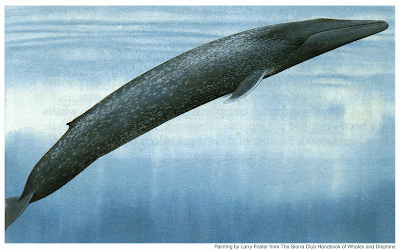The Blue Whale
Ecology
 |
| Catalyzing Change |
Gliding toward you through the apparent
serenity of the open water, its mottled grey body disguised as blue by the
chill ocean, the largest animal on earth makes its presence known. No leaps and
bounds are needed to feel the regality of the Blue Whale. Reaching a maximum
body length of 36 yards, and a weight of more than 165 tons, this whale is the
largest living thing known to man. The Blue Whale is a baleen whale – they take
tons of food-laden water into their expandable throat area and discard the
water through their baleen plates, leaving only the krill to swallow. This
system allows the largest animal on earth to feed on some of the smallest – consuming
around 8,000 pounds of krill per day.
 |
| National Geographic |
The Blue Whale has a “slow” life history, bearing
one calf every 2-3 years and living for up to 90 years. They are a migratory
species – swimming poleward in the spring to feed, and toward the subtropics in
the fall to reproduce and reduce their energy use while fasting.
While this range of movement hasn’t
changed in recent years, the population of blue whales have. Before the
beginning of industrialized whaling, more than 360,000 Blue Whales roamed throughout
every ocean. They were nearly exterminated – with nearly 99% of their
population gone – by 1966 when they received protection from the International
Whaling Committee (IWC). In 1931 alone, at the height of the whaling period,
about 29,000 Blue Whales were killed in one season. Currently there are about 8,000-14,000 Blue Whales left in earth’s oceans.
Human Impacts
 |
| Science Blogs: Shifting Baselines |
As you can see, hunting by humans has been the main constituent
in the decline of the Blue Whale. However, even after hunting was banned humans
continued to impact whale populations. Collisions with ships in the 1990s have
resulted in the deaths of at least 10 Blue Whales, and potentially a large
amount of injuries. Habitat degradation from acoustic and chemical pollution is
also a concern. While their diet of plankton makes them less susceptible to
accumulations of pesticides and other contaminates, acoustic pollution (such as
sonar and underwater noise from military and commercial ship traffic has been
known to produce a “startle response.” This startle response
can result in the
loss of feeding time and area and the
excessive burning of precious calories,
especially in the winter.
Recovery
 |
| Travel Connected |
In light of this severe depletion,
in 1970 the Blue Whale was listed as “endangered” under the Endangered Species
Conservation Act, and when the Endangered Species Act (ESA) passed in 1973 the
Blue Whale was listed as “endangered” throughout its range. It is also listed
as “depleted” under the Marine Mammal Protection Act.
As part of their status as “endangered,” the government
had to create a recovery plan for the Blue Whale. The goal of this recovery
plan is to “identify a set of actions that will minimize or eliminate effects
from human activities that are detrimental to the recovery of blue whale populations” (National Marine Fisheries Service).
The plan consists of 8
primary steps:
- Determining the population structure remaining blue whales populations
- Estimating populations size and monitoring trends in population fluctuation
- Identifying and protecting essential habitats
- Minimizing or eliminating human-caused casualties
- Determining and minimizing effects of vessel interactions
- Maximizing efforts to gather information from deceased animals
- Coordination with state, federal, and international efforts to implement this recovery plan
- Establishing a criteria of whether to delist or downlist
What Can You Do?
Despite human assistance in its recovery, the Blue Whale has a long way
to go. Just like the first steps in the recovery plan are focused around
gaining data, the most important thing you can do to help is spread knowledge.
The more people know, the more they can help. So spread the word.
To learn more about Blue Whales or to make a donation to help their
recovery, you can visit WWF at http://wwf.panda.org/what_we_do/endangered_species/cetaceans/about/blue_whale/.
 |
| World Wildlife Fund (WWF) |
References
"Balaenoptera
Musculus." NatureServe. Vol. 7.1. Arlington, VA: NatureServe, 2015.
NatureServe Explorer: An Online Encyclopedia of Life. Web. 20 Oct. 2015. http://explorer.natureserve.org
National Marine
Fisheries Service. 1998. “Recovery plan for the blue whale (Balaenoptera musculus).”
Prepared By Reeves R.R., P.J. Clapham, R.L. Brownell, Jr., and G.K. Silber for
the National Marine Fisheries Service, Silver Spring, MD. 42 pp.
"Blue Whale."
WWF Global. World Wide Fund for Nature, 2015. Web. 25 Oct. 2015. http://wwf.panda.org/what_we_do/endangered_species/cetaceans/about/blue_whale/
"Blue
Whale." American Cetacean Society. American Cetacean Society, n.d. Web. 10
Nov. 2015. http://acsonline.org/fact-sheets/blue-whale-2/
"Blue Whale:
Federally Endangered." Alaska Department of Fish and Game. State of
Alaska, n.d. Web. 13 Nov. 2015. http://www.adfg.alaska.gov/index.cfm?adfg=specialstatus.fedsummary&species=bluewhale
"Blue Whale
(Balaenoptera Musculus)." ECOS Environmental Conservation Online System.
U.S. Fish & Wildlife Service, n.d. Web. 01 Nov. 2015. http://ecos.fws.gov/tess_public/profile/speciesProfile?spcode=A02M
Reilly, S.B.,
Bannister, J.L., Best, P.B., Brown, M., Brownell Jr., R.L., Butterworth, D.S.,
Clapham, P.J., Cooke, J., Donovan, G.P., Urbán, J. & Zerbini, A.N. 2008. “Balaenoptera
musculus.” The IUCN Red List of Threatened Species 2008: e.T2477A9447146. Web.
01 Nov. 2015. http://www.iucnredlist.org/details/2477/0
Blog by Sydney Gallion

I found all of this information on the blue whale very interesting. While I knew that this species was endangered, the statistics surprised me. Your graphs and maps were a helpful aid to the blog. I like how you clearly listed out the 8 steps to recovery as well as bullet pointing them. This made them stand out, and the recovery process is the most important information. #BIO227Fall2015
ReplyDelete